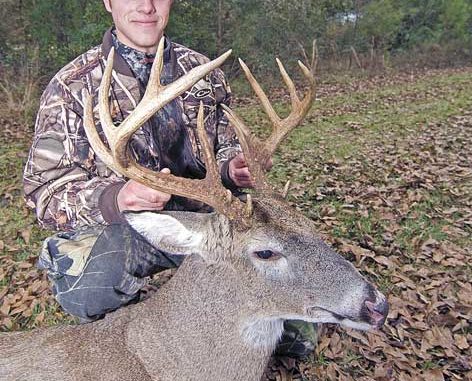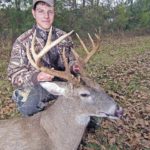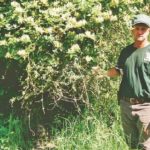
Find one of these nine plants, look for signs of browsing and set up a stand. That’s all it takes to kill early season deer.
The rut is easy for hunters, providing a time of the season when deer are moving about looking for love without a care in the world.
But what is a hunter to do before that wondrous time begins?
One strategy that might pop to mind is targeting feed trees, and surely that’s a grand scheme. Deer love acorns and pecans, so it makes sense to set up on an active tree and ambush deer as they ease in for a bite to eat.
It’s when the mast crop is a bust that things really get screwy. That sends many hunters into deep depression because, as a group, we have lost the ability to hunt deer where they live.
Oh, sure, we always have our food plots, and that seems to be the default for us new-age hunters.
“An awful lot of our hunters just hunt permanent stands over food plots,” Department of Wildlife & Fisheries’ Scott Durham said. “It’s amazing. A lot of guys ride a bike 100 yards from a stand, and climb into that stand and just sit there, hunt after hunt.”
Even early season bowhunters too often focus on deer easing into these green patches. And that might work for a few hunts, but eventually deer get wise.
“When you get a group of does coming out and you shoot one, the other deer become reluctant to come out,” former state deer study leader Dave Moreland explained. “They come out right at dark, or they wait until the sun goes down.”
However, there is another option: Setting up on natural browse in the woods, finding those plants deer love to munch and ambushing them where they least expect it.
“Last year I found some trumpet creeper on Pearl River (Wildlife Management Area), and every other step there was browsed plants,” Moreland said.
The life-long hunter set up on the carpet of vegetation the first day of the primitive-weapon hunt, and wasn’t disappointed.
“I had a 6-point come into the trumpet creeper,” Moreland said. “It was a basket-rack, and I decided not to shoot it, but that shows just how effective hunting browse can be.”
Of course, there are a couple of obstacles the average hunter must conquer to effectively implement this tactic.
First, it must be understood that not everything green is eaten by deer.
“You can disregard a lot of what’s out there,” Durham said. “Deer prefer some species, and those are the ones you want to focus on.”
That brings up the second hurdle — plant identification. However, it’s not as hard as many might think.
“You don’t have to learn every browse species,” Moreland said. “If the hunter focuses on a few species that are available during hunting season, it’s not that difficult.”
While there are certain species that are specific to each region of the state, Moreland said there are nine basics hunters can focus on no matter where they hunt: elderberry, American beauty bush (a.k.a. French mulberry), rubus (blackberries and dewberries), privet, trumpet creeper, honeysuckle, yellow jassemine and verbena.
The key to effectively hunting any of these is to find concentrations.
“I’m looking for clusters of privet or rubus or whatever,” Moreland said.
However, simply finding a large number of French mulberry, for instance, won’t automatically translate into the opportunity to kill a deer. After all, it’s hard to get a shot if deer aren’t feeding on that particular group of mulberry.
So it’s critical to determine which clusters of browse are being actively and consistently fed upon.
Moreland said there are distinct hints that deer are favoring a particular browsing species and location. But whereas many hunters look for droppings when deciding which oak tree to hunt, that’s not the deciding factor when targeting browse.
“I’m just looking for stem bites, and I’m looking for a place where there’s lots of it,” Moreland explained.
In other words, he’s examining the plants to see if deer have been feeding there.
Now, that might sound confusing, since rabbits and other critters could be munching on the same vegetation.
But it’s really not that difficult.
“A rabbit will cut a stem at a 45-degree angle,” Moreland said. “A deer bite will be like he pulled it off, broke it off.”
About the only thing to be careful of is that you don’t focus on insect damage.
“Insect damage can be mistaken for deer browsing,” Durham said. “They’ll cut it off, but it’ll look like a deer. But typically you’ll see some little eaten-out spots on the remaining leaves.
“There will also be a black band on the end of insect damage. You won’t see that on deer browse.”
On shrubs like privet, deer will bite off new stems, but they also will snip leaves. That means hunters can look for bushes with small, newly sprouted leaves as evidence of heavy browsing.
Once you have identified a well-used cluster of deer browse, there really is no magic to hunting it.
“You look for trails,” Durham said.
Moreland said when there are multiple trails in an area, he keys on those that provide quickest access to the food source.
“Deer are like humans — they like to travel the easiest route,” he said.
Those are the routes on which archery hunters should focus, while gun hunters during the early season can back off and up their odds by setting up within range of multiple clusters of heavily browsed vegetation and the trails used to access these natural buffets.
And those hunters who educate themselves in identifying a few key species can reap huge rewards when other, lazier hunters are complaining that deer aren’t stepping into their favorite food plots.
“It makes you more aware, and it makes you a better hunter,” Durham said.




